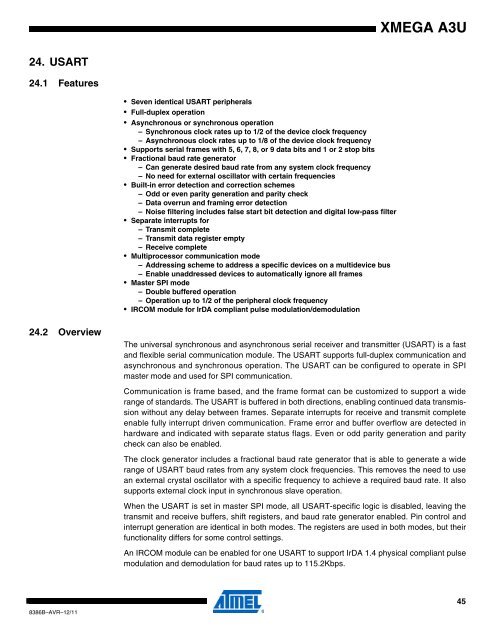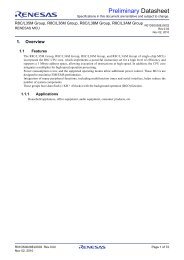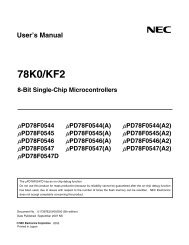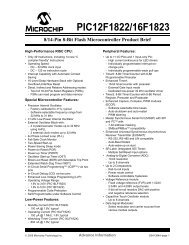xmega a3u - Elfa
xmega a3u - Elfa
xmega a3u - Elfa
You also want an ePaper? Increase the reach of your titles
YUMPU automatically turns print PDFs into web optimized ePapers that Google loves.
XMEGA A3U<br />
24. USART<br />
24.1 Features<br />
• Seven identical USART peripherals<br />
• Full-duplex operation<br />
• Asynchronous or synchronous operation<br />
– Synchronous clock rates up to 1/2 of the device clock frequency<br />
– Asynchronous clock rates up to 1/8 of the device clock frequency<br />
• Supports serial frames with 5, 6, 7, 8, or 9 data bits and 1 or 2 stop bits<br />
• Fractional baud rate generator<br />
– Can generate desired baud rate from any system clock frequency<br />
– No need for external oscillator with certain frequencies<br />
• Built-in error detection and correction schemes<br />
– Odd or even parity generation and parity check<br />
– Data overrun and framing error detection<br />
– Noise filtering includes false start bit detection and digital low-pass filter<br />
• Separate interrupts for<br />
– Transmit complete<br />
– Transmit data register empty<br />
– Receive complete<br />
• Multiprocessor communication mode<br />
– Addressing scheme to address a specific devices on a multidevice bus<br />
– Enable unaddressed devices to automatically ignore all frames<br />
• Master SPI mode<br />
– Double buffered operation<br />
– Operation up to 1/2 of the peripheral clock frequency<br />
• IRCOM module for IrDA compliant pulse modulation/demodulation<br />
24.2 Overview<br />
The universal synchronous and asynchronous serial receiver and transmitter (USART) is a fast<br />
and flexible serial communication module. The USART supports full-duplex communication and<br />
asynchronous and synchronous operation. The USART can be configured to operate in SPI<br />
master mode and used for SPI communication.<br />
Communication is frame based, and the frame format can be customized to support a wide<br />
range of standards. The USART is buffered in both directions, enabling continued data transmission<br />
without any delay between frames. Separate interrupts for receive and transmit complete<br />
enable fully interrupt driven communication. Frame error and buffer overflow are detected in<br />
hardware and indicated with separate status flags. Even or odd parity generation and parity<br />
check can also be enabled.<br />
The clock generator includes a fractional baud rate generator that is able to generate a wide<br />
range of USART baud rates from any system clock frequencies. This removes the need to use<br />
an external crystal oscillator with a specific frequency to achieve a required baud rate. It also<br />
supports external clock input in synchronous slave operation.<br />
When the USART is set in master SPI mode, all USART-specific logic is disabled, leaving the<br />
transmit and receive buffers, shift registers, and baud rate generator enabled. Pin control and<br />
interrupt generation are identical in both modes. The registers are used in both modes, but their<br />
functionality differs for some control settings.<br />
An IRCOM module can be enabled for one USART to support IrDA 1.4 physical compliant pulse<br />
modulation and demodulation for baud rates up to 115.2Kbps.<br />
8386B–AVR–12/11<br />
45

















